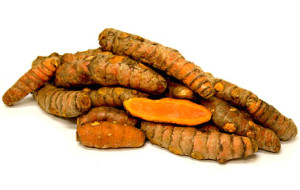By Kim Robson:
When you’re in pain, pharmaceutical drugs don’t have to be your only path to pain relief. Many natural foods and herbal substances can provide significant pain mitigation.
Capsaicin Derived from hot chili peppers, topical capsaicin may be useful in relieving pain for some people. Capsaicin  works by depleting substance P, a compound that conveys the pain sensation from the peripheral to the central nervous system. Taken internally, capsaicin is said to stimulate healthy digestion, help maintain a healthy metabolism, and support vascular health.
works by depleting substance P, a compound that conveys the pain sensation from the peripheral to the central nervous system. Taken internally, capsaicin is said to stimulate healthy digestion, help maintain a healthy metabolism, and support vascular health.
Ginger extract may help with joint and muscle pain because it contains phytochemicals, which help stop inflammation. Few side effects have been linked to ginger when taken in small doses.
Comfrey leaves and root are highly valued as an external remedy for sprains, swellings, bruises, severe cuts, boils, abscesses, and gangrenous and ill-conditioned ulcers. The whole plant, beaten and applied hot as a poultice, is excellent for soothing pain in any tender, inflamed or suppurating part. It is an effective astringent for any kind of inflammatory swelling. Keep a tiny zip pouch with a half teaspoon of ground comfrey root: when, mixed with saliva and applied directly to a wound as a poultice, it will stop bleeding almost immediately.
Clove Oil is a natural numbing agent. It is most commonly used for toothaches, but also can be used on the skin to alleviate painful cuts and bruises. It has been used for centuries to treat oral pain. The oil is extracted from the bud, leaf and stem of the plant; and it possesses antiseptic, analgesic, antibacterial and local anesthetic properties.
Feverfew has been used for centuries to treat headaches, stomachaches and toothaches. Nowadays it’s also used for migraines and rheumatoid arthritis. Mild side effects include canker sores and irritation of the tongue and lips. Pregnant women should avoid feverfew.
Turmeric can be used to relieve arthritis pain and heartburn, and to reduce inflammation. Its activity may be due to a chemical called curcumin, which has anti-inflammatory properties. Turmeric is usually safe to use, but high doses or long-term use may cause indigestion. Also, people with gallbladder disease should avoid using turmeric.
chemical called curcumin, which has anti-inflammatory properties. Turmeric is usually safe to use, but high doses or long-term use may cause indigestion. Also, people with gallbladder disease should avoid using turmeric.
Devil’s Claw – Scientific evidence suggests that this South African herb may be effective in managing arthritis and lower back pain. Side effects are very rare if taken at a therapeutic dose for the short term, but it’s not advised for pregnant women and those with gallstones, or stomach or intestinal ulcers.
There are many other herbal remedies for natural pain relief, such as boswellia and willow bark. The American Pain Foundation also lists these herbs for pain management:
- Ginseng for fibromyalgia
- Kava Kava for tension headaches and neuropathic pain
- John’s Wort for sciatica, arthritis, and neuropathic pain
- Valerian root for spasms and muscle cramps











Amber Begay
I am surprised by reading this article. The pain relievers are in my kitchen and I bought most of them from medical shops. Thank you for this kind information.